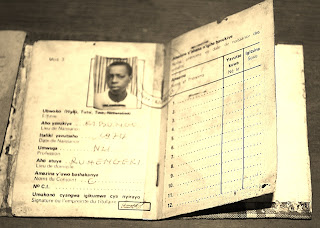As we arrived to the site, we observed a sombre air. We were advised that photography was not allowed inside the church, and as soon as we got closer we realized why. While the bodies have been removed from the church, the clothes of the deceased remain, piled up on the church pews. Steve – who spent some time in Afghanistan – did a positive ID on bullet holes in the clothes. Just piles and piles of dead peoples’ clothing. Inside a church. Bullet holes are visible in the walls…yet at the back of the church, the statue of mother Mary remains unscathed – a few blots of staining on her, but that’s about it. She looks serenely down at the church. What did she see that day as thousands of men, women and children were mercilessly slaughtered? We asked the guide – what did the priests here do to stop this? He looked at us and answered – ‘nothing’.
We then proceeded to the room underground where the remains of bodies are kept. Some are piled 20 bodies (just bones now) to a casket while other skulls and bones remain respectfully on display. You can tell the ones that were killed by a machete to the head. A clean slice through the skull leaves no guesses as to what happened to that poor individual. As we made our way into the second underground tomb, Dave nearly face-planted into a pile of skulls as he missed a step. In another situation this might be funny, but this time around all it did was convince me I really didn’t want to go down there to see the remains of hundreds of more people.
Feeling a bit sickened I joined the group as we headed to the next church in a place called Nytarama. Again, we saw the clothes and personal effects of the people who died in the church. Among the remains were a couple of ID cards. These ID cards, originally promoted by the church in the 30s, eventually became the death warrants for anyone of Tutsi origin during the genocide in 1994. Essentially, people were stopped at road blocks, asked for their ID, and if they were identified as Tutsi, they were then killed without discussion. The lady at the memorial allowed us to take a picture of this card, which surprised me immensely. But we took the picture as we feel people need to know and understand what happened here, especially given the way Rwanda was ignored by the world during its 100 day descent into hell. I personally remember living in Dubai at the time the genocide would have been happening – I clearly remember the headlines during that year – OJ Simpson and Tonya Harding going apeshit on Nancy Kerrigan. I don’t remember a thing being said about Rwanda. Do you?
We then walked through to a couple other rooms. One was a kitchen – when the people inside wouldn’t come out, the genocidaires just burned the place. In here we found a human vertebrae which made me shudder, given my particular sensitivity to anything to do with spines.
We then walked to the third building which was the place where the children were housed for Sunday School. At the far end of the room was a bit of brick wall that had been burnt and blackened. It was only when the tour guide started explaining what we were seeing that I realized the horrific truth. The blackened area wasn’t a burnt spot – it was the blackened remains of dried up blood – this was where the genocidaires killed the children – by smashing them against the walls.
I recognize this post is heavy. No funny anecdotes about the kids, no positive stories about what we’ve come to admire about this place. Just the cold truth about two horrific incidents, among hundreds, the remains of which we got to observe personally.
As we walked away from the church, we passed by a primary school and as per usual the kids came out to say hello and give us hugs. I saw them running fervently towards something and I said to Robyn ‘What are they running towards’ and then a split second later ‘Oh my God, they’re running towards us, brace yourself’ Everywhere we go, the kids want to hug us. Their parents usually smile and wave. I guess what amazes me is how a country that was ignored by us at their time of need, can still embrace us with welcoming arms. Where were the Canadians when Rwanda was dying? Well – there was one Canadian TRYING but failing to do much due to the UN Handcuffs. But the rest of the world was silent and looking the other way. It’s shameful to think this was allowed to happen. And to realize its happening still – in Darfur, in the Congo – thousands of people are being killed, maimed, raped or orphaned. So today I have one request if you’re reading this blog. Please find one war-related cause to read about, and sign a petition or offer support to an organization that’s trying to help the civilians that suffer the most. Write a letter. Do something small, in your own way, to speak up for someone who is suffering and desperately needs the world to help.
- Dal |
| Descending the stairs to see the bones of over 45,000 victims |
 |
| This is the ID card that was mandatory to carry. He was killed because she's a Tutsi. |
 |
| This photo was taken in Sunday school room for children. The blood stain remains from the violence in 1994. |
 |
| Some of the clothes of the people that died while in the church. |
 |
| Ntarama Genocide Memorial Sign. |
No comments:
Post a Comment